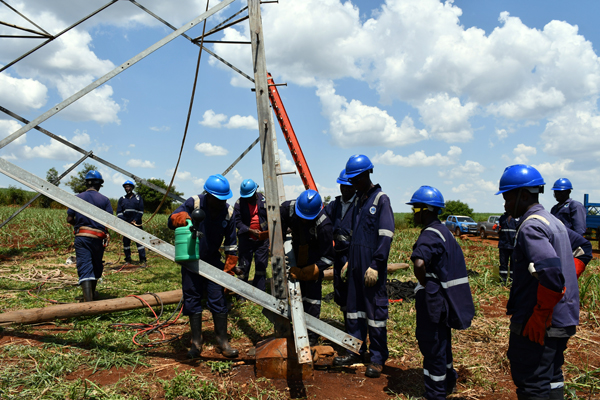Vandals, inside theft and ageing grid damn UETCL

The amount of money that the Uganda Electricity Transmission Co Ltd (UETCL) spends to transmit electricity has significantly risen due to an ageing grid, a 2023 value-for-money audit by the Auditor General (AG) has revealed.
The audit shows that the actual expenditure for some of the activities under the electricity grid operations and maintenance exceeded what the UETCL board had reallocated between 2020 and 2023. The company’s board reallocated its grid operation and maintenance budget to Shs10.91b in the Financial Year (FY)2020/2021. Consequently, the company’s total expenditure climbed to Shs11.889b.
In FY 2021/2022, UETCL spent Shs12.726b, more than the budgeted Shs11.952b on grid operation and maintenance. The audit indicates that in the four years, UETCL’s operations and maintenance budget largely comprised transmission line repairs and pole treatment, Supervisory Control and Data Acquisition (SCADA) system maintenance, and substation repairs and maintenance.
Expenditures channeled towards operation and maintenance of electricity infrastructure accounted for Shs19.64b (43 percent), Shs3.96b (nine percent), and Shs9.86b (22 percent) respectively. It was discovered that the transmission lines prone to faults, failures, and vandalism were those constructed with wooden materials and steel structures.
The Owen Falls Dam-Lugogo line, for instance, constituted 13 percent of the total operation and maintenance spending, which was, to a large extent, due to vandalism. Elsewhere, the Nkonge-Nkenda wooden line and the Opuyo-Lira line in Tororo accounted for 17 percent of the expenditure. This was after it incurred an expenditure of Shs3.2m per kilometre above the company average of Shs2.5 million over the four-year stretch.
“Following the analysis of UETCL's transmission line maintenance expenditure in FY2022/2023, the average spending per kilometre of network route length was found to be Shs2.3m. This marks a 94 percent increase from the average expenditure of Shs1.2m per kilometre in FY2019/2020,” John Muwanga, the former AG, wrote in the audit report.
Cost of interruptions
A review of UETCL’s system operation data for the three tariff years of 2020, 2021, and 2022 revealed that certain transmission lines were affected by inadequate voltage regulation. In 2020, for example, voltage interruptions resulted in outages on 18 transmission lines lasting 6,803 hours. Despite a fewer number of transmission lines experiencing outages due to voltage interruptions in 2021, the time the lines took off power before restoration nearly doubled to 11,177 hours. It, however, dropped significantly to 1,056 hours in 2022, with 28 lines of power, an indication of an improvement in managing outage durations.
Experts say the deliberate shutting down of the transmission lines is discouraged as an approach to controlling high grid voltages because it affects the availability and reliability of the transmission grid. The outage duration compared against the planned outage schedule of 90 hours for each of the tariff years of 2020, 2021, and 2022 stood at 62.89 hours, 97.32 hours, and 31.4 hours respectively.
Transmission lines such as Owen Falls-Lugogo 1 & 2 (132Kv) and Kabulasoke-Nkonge (132Kv) consistently featured in all three years, with more than 10 shutdowns annually. This pointed to potential ongoing performance issues that may not be adequately addressed through scheduled maintenance alone. According to the audit, 5.3 gigawatt-hours (GWh), 2.9 GWh, and 3.4 GWh were recorded as the total energy not supplied due to faults in 2022, 2021, and 2020. This captured the severe operational challenge the transmission company currently faces.
Energy that ends up not being supplied occurs when the transmission network experiences disruptions. This leads to interruptions in the electricity supply to the distribution companies that supply the end user.
The audit also established that the lost energy translated into a Shs2.64b revenue loss to the government. Specifically, in 2020, energy worth Shs775m was lost; Shs661m in 2021, and Shs1.208b in 2022.
“The transmission company does not only incur the direct costs associated with addressing and repairing the faults but also the indirect costs of potential revenue loss due to the unavailability of transmitted energy during these interruptions,” Mr Muwanga noted, adding that the increase in potential revenue loss suggests a growing impact of unplanned grid interruptions.
These prolonged outage times signify, Mr Muwanga offered, challenges in the reliability and resilience of these transmission lines and overall network performance.
Old, outdated metres
According to the energy metre register of UETCL, there are 211 energy metres. The metres under substation energy metres, standalone energy metres, and power producers’ metres categories are said to be due for replacement owing to time drift, age, battery warning, and suspected accuracy drift. UETCL says the most affected category of energy metres that are due for replacement are substations with 95 energy metres, standalone with 102 energy metres, and power producers with six metres.
It is also revealed that 48 out of 95, representing 51 percent of the substation energy metres, and 39 out of 102, representing 38 percent of the standalone energy metres, have exceeded the recommended 10 years, contrary to international utility best practices. Auditors found out that energy metres in strategic locations such as Mpondwe (Kasese District), Katuna, Cyanika, the KPLC1 132 kV transmission line at Tororo, and the Kyaka transmission line are overdue for replacement, potentially leading to higher revenue losses due to failure to transmit power across the borders.
In the FY2020/21, International Energy Technik was contracted to supply replacement energy metres under the contract UEUCL/SUPLS/2020-21/00378/2. “The impact of not promptly replacing these energy metres poses an increased risk of billing disputes, both domestic and regional, involving UETCL clients and other generating plants,” the report stated.
Vandalism
Meanwhile, UETCL spent billions to repair and conduct remedial works on key electricity transmission lines between 2020 and 2023 due to theft and deliberate vandalism. The audit revealed that the cost of restoring vandalised Owen Falls-Lugogo 132Kv structures alone was up to Shs8.4b.
On the Owen Falls-Lugogo 132 Kv Line, vandalism at Lugalambo in Buikwe District brought four towers (no. 47, 48,49, and 50) down on December 23, 2022, due to leg hacking by vandals and severely constrained power evacuation from eastern Uganda to Kampala. On the same line around Kivuuvu Village in Mukono District, steel lattice towers 161, 162, 163, and 164 earlier on November 12 fell after vandals hacked them.
Whereas recoveries of some vandalised materials were reportedly made, with Emergency Restoration System (ERS) towers temporarily erected, it was revealed that the recovered materials could not be used after exceeding their intended use due to delayed decisions on using monopoles or replacing the towers.
Along the Owen Falls-Lugazi 66 Kv line, the vandals did not spare towers 45, 84, 86, 94, and 95, which they brought down. Although the operations and maintenance replaced tower 95 with wooden poles, the wooden structure was found not to be robust enough, resulting in frequent shutdowns.
While the Mukono-Namanve 132 Kv line experienced tripping due to vandalism of towers 65, 68, and 69, the Bujagali-Tororo line faced delays due to right-of-way (land) acquisition challenges and cash flow issues, resulting in vandalism on incomplete towers.
“The Karuma-Kawanda 248km, 400Kv double-circuit line for circuits No. 1 and 2 was energised on November 28, 2021 and March 21, 2022, respectively. However, on December 15, 2022, five towers collapsed due to vandalism (491, 492, 493, 494, and 495),” the report reads in part.
Specific transmission lines like the Karuma-Kawanda 400 kV line experienced tower collapse due to vandalism, leading to additional costs and delays. Towers 491, 492, 493, 494, and 495 remained grounded at the time of the audit after they were cut down by vandals on December 15, 2022. While the Bujagali-Tororo 220 kV transmission line also faced severe vandalism, the two lines are specifically critical for evacuating power from the incomplete Karuma dam and exporting power to Kenya.
“The incidents of vandalism on the incomplete unstrung towers have left UETCL with no choice but to demobilise most of these members to preserve the materials,” Mr Muwanga noted.
Internal theft
Meanwhile, dysfunctional closed-circuit television (CCTV) cameras installed at electricity substations and around the company’s various storage facilities, coupled with internally syndicated theft incidents, are said to have catalysed vandalism and theft of already recovered materials. It is said that the current CCTV coverage at UETCL sites and premises is not only limited to the presence of only 137 installed cameras designated for security monitoring but 38 (27 percent) of the cameras are said to be defective.
During the audit, significant gaps in surveillance were identified at the Tororo pole plant, where no CCTV cameras were installed. This deficiency became apparent when angle stubs from the Hoima-Nkenda 132Kv were stolen on July 11, 2022. Elsewhere, when, on February 2, 2023, the theft of around 110 metres of copper earth wires from Masaka-West Substation took place, there was no recorded footage for retrieval or investigation.
“Visits to the Iganga substation exposed instances of theft and vandalism of the palisades on the outer fence, directly attributed to the limited coverage provided by the existing CCTV system. The poles anchoring the cameras at the substation are too short, restricting their field of vision,” the report discloses.
Moreover, the substation operates with only four guards—two during the day and two at night. They are, says the report, “insufficient to efficiently monitor the entire eight-acre station.” A separate review of the security reports uncovered operational deficiencies in the outsourced security services provided by firms employed by UETCL. For instance, auditors cited an October 24, 2021 incident in which joint investigations by police, the UETCL security section, and Ultimate Security Limited disclosed potential collaboration between some Ultimate Security Limited staff and thieves who orchestrated the theft of cables from the Kasana substation in Luweero District. The theft incident involved three drums of optical fibre composite overhead ground wires valued at Shs139.3m.
The theft of angle stubs from the Nkenda-Hoima 132Kv line was reportedly carried out by a security guard employed by Ultimate Security Company Ltd, the investigations revealed.
“These instances highlight a critical performance gap in the oversight, supervision, and efficacy of security measures implemented by outsourced firms. As a result of the identified deficiencies in UETCL's security infrastructure, including limited CCTV coverage and operational lapses in outsourced security services, timely detection and investigation of security incidents are hampered, allowing theft and vandalism to go unchecked,” the report reveals.
Dire situation
Today, Uganda has up to 33 power generation plants that supply electricity to the national grid. These include four large hydropower plants, 19 small hydropower plants, two thermal (Heavy Fuel Oil) power plants, three bagasse-based cogeneration power plants, and five Solar PV power plants.
The current generation capacity is derived from four energy sources: hydro (1023.59 MW); thermal (100 MW); cogeneration (63.9 MW); and grid-connected solar (60 MW). The generated electricity is transmitted by UETCL, the national operator of the high voltage transmission grid.
The report recommends a set of measures that the power transmitter should undertake to avert the issues, including expediting the investment in monopoles for high-risk areas to replace the steel pylons.
“Enhance the procurement and repair of CCTV cameras with expanded coverage, consider advanced technologies for real-time detection and alert, and increase security personnel at vulnerable locations like the Iganga substation,” it recommends.
To salvage the situation, the audit tasked UETCL to procure and install shunt reactors in affected areas to control high grid voltages and replace the ageing metres.
“Expedite the replacement of ageing energy metres to mitigate associated risks. Address overdue replacements in strategic locations like Mpondwe, Katuna, Cyanika, KPLC1 132 kV transmission line at Tororo, and Kyaka transmission line,” it stated.
UETCL, ERA speaks out
In an emailed response to Saturday Monitor, Mr Joshua Karamagi, the UETCL managing director, stated that funds had been allocated to procure monopoles. Installation, he added, will be completed in 2025.
“The Electricity Regulatory Authority (ERA) provided Shs9b to procure monopoles for high-risk areas to replace the collapsed steel lattice structures along the 132 kV Owen Falls Lugogo Transmission Line. This will be completed by 2025,” he wrote, adding that new CCTV cameras have since been installed in most of the substations to expand coverage at Fort Portal Substation, Mbarara North Substation, Mbarara South Sub-station, and Bujagali Sub-station, among others.
Per Mr Karamagi, 60 new energy metres have been procured and replacement of the old energy metres is currently ongoing, having started with the Lugogo Sub-station. The 60 metres “shall be inadequate to cover all the nodes as highlighted in the report.”
UETCL is already engaging ERA “in the next capital budget application for 2025 to provide additional energy metres.”Mr Karamagi also said the installation of shunt reactors is ongoing on Fort Portal Substation after completing installation of the same at the Kole and Arua substations by July 2024. We have established that the electricity sector regulator, ERA has Okayed UETCL to inject billions of shillings into the procurement and installation of monopoles.Mr Julius Wandera, the ERA spokesperson told this publication that the replacement will prioritise highly susceptible lines and will be conducted in a phased manner due to resource constraints.
“What we all agree is that vandals are giving us a hard time and we need to urgently transit to monopoles and we shall only be able to do selective replacement, you cannot replace the whole line because of the cost issues,” Mr Wandera said, adding that although a single monopole costs about Shs600m,“we need them desperately, but then in needing them, when you need to use the tariff to raise that money, you need to be extra careful, otherwise the tariff will not be affordable to users.”Mr Wandera, however, refutes the report’s findings that the UETCL is incurring losses resulting from an ageing transmission system.
“Our transmission losses are not so bad. It is at three percent and the global benchmark ranks between three and five percent, so if someone says we have huge losses on transmission due to the ageing system, then that audit needs to be reflected on for the second time.”
The ERA official also attributed the delayed replacement of wooden poles in several parts of the country to “opportunistic lawyers” whom they allegedly discovered to be inciting landowners against the compensation valuation.“This has stalled many transmission lines for too long such as the one between Tororo and Mbale; and Tororo and Jinja in the areas of Bugiri, as well as Mbale to Soroti,” Mr Wandera said.
Although access to electricity is gradually increasing in Uganda, in 2021, the coverage reached only 42 percentof the population. Both grid and off grid connections account for 42 percent of access to electricity in Uganda.The term g rid connection refers to access to power through the national electricity grid.
The Uganda National Household Survey 2019/2020 states that Uganda’s electricity grid reaches 18.9 percent of its population, m ain ly in the urban areas.









0 Comments